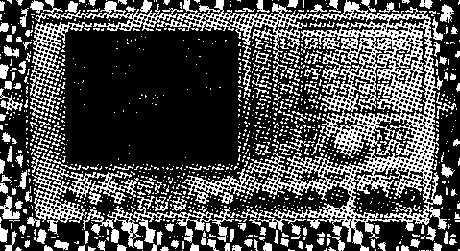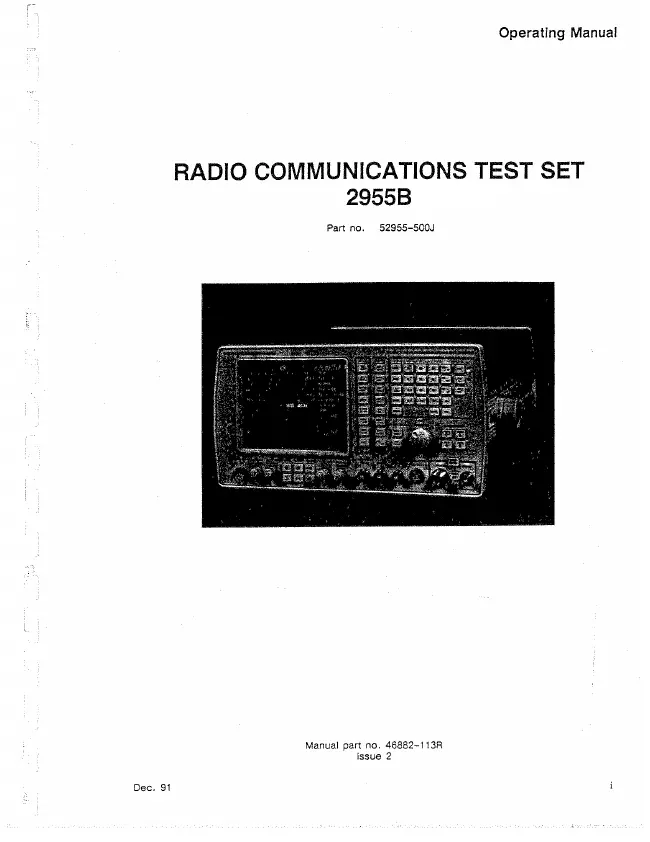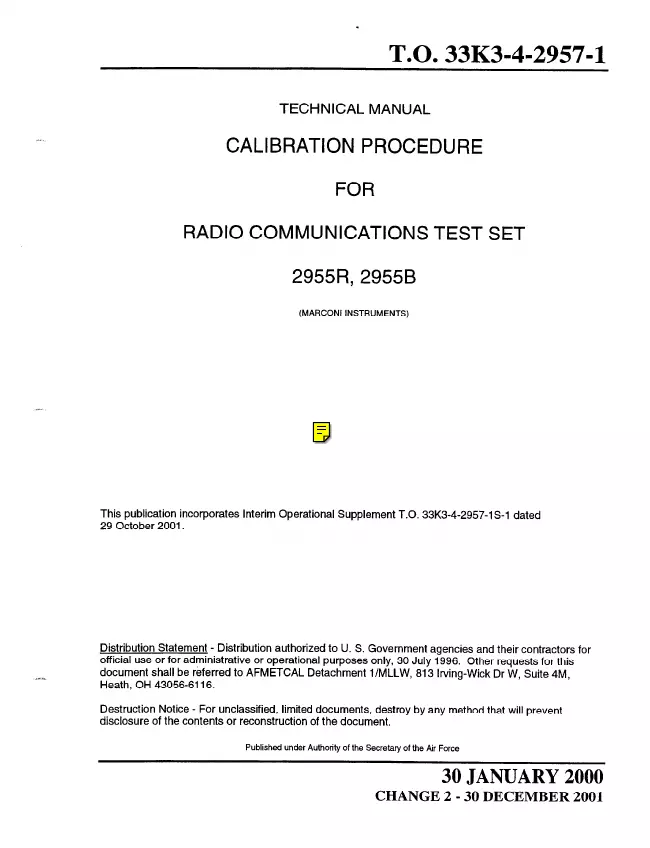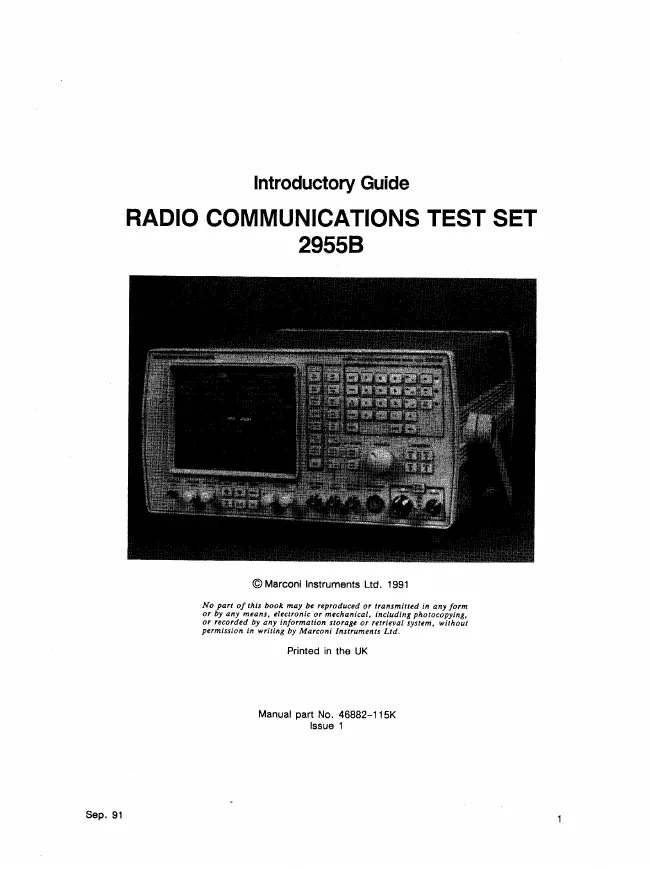Marconi - 2955B - Communications Test Set
Manufacturer:

Image 1 of 2
If you have any other photos or manuals for the
Marconi 2955B
you can
upload the files here.
Equipment:
2955B
Date:
1991
Category:
Group:
Sub Group:
Information
Radio Communications Test Set type 2955B combines ail the
measurement
facilities required for testing mobile radio transceivers in
the range up to 1000 MHz. it is
a compact self-contained unit designed for bench or mobile
use and can be considered as
a combination of the following instruments:-
RF frequency meter.
AF frequency meter.
RF signal generator.
AF generators (two).
RF power meter.
AF and DC voltmeter.
Modulation meter.
AF distortion, S/N or SIN AD meter.
Digital storage oscilloscope.
Sequential tones decoder and encoder.
DTMF decoder and encoder.
DCS decoder and encoder.
POCSAG radio pager encoder
Push-button selection makes all the necessary
interconnections for each measurement,
eliminating the need for the many interconnections required
when separate
instruments are used. Function selection and data entries
are made on a colour-coded
keyboard with the operating sequence logically arranged from
left to right. Instrument
operation is greatly facilitated by means of CRT displays
which provide prompts during
data entry and guidance during operating sequences while
also showing the instrument
settings and the measurement results. The measurement
results are displayed by digital
readouts and also by either autoranging bar charts or by a
storage oscilloscope which has
repetitive sweep, single shot and freeze facilities.
Frequency meters. As there are two frequency counters,
simultaneous AF and RF
frequency readings can be displayed. Ranges and resolutions
are respectively from 20 Hz
to 20 kHz at 0.1 or 1 Hz and from 1.5 to 1000 MHz at 1 or 10
Hz. Either an internal or
an external frequency standard can be used.
Signal generator. The signal generator can be amplitude,
frequency, or phase modulated,
internally or externally, the internal modulating signal
being obtained from the AF
generators. Amplitude modulation is variable up to 99% for
carrier frequencies from 0.4
to 500 MHz. FM deviation can be set from 0 to 25 kHz and ΦΜ
deviation from 0 to 10
radians. Transmitter and receiver RF signals use N and BNC
connectors which are
selected by means of a key. Reverse power overload is
indicated by a visual warning and
an audible alarm. When a reverse power overload is applied
to the BNC socket, an
automatic trip circuit operates*
Modulation meter. Automatic frequency tuning and levelling
of the modulation monitor
provide accurate measurements of AM, FM and ΦΜ. Because of
the independent tuning,
modulation measurements can be made on duplex systems. The
modulation can be
observed on an oscilloscope and its symmetry checked from
the peak and trough values
displayed on a dual bar chart. The demodulated output is
available at a rear panel
socket. Provision is made for audible monitoring using the
built-in loudspeaker or by an
external loudspeaker or headphones.
RF power meter. The absorption RF power meter measures up to
75 W continuously or
up to 150 W for short periods over a frequency range of 1.5
to 1000 MHz. The
connection of the RF Directional Power Head (available as an
optional accessory) extends
the capability of the instrument by enabling measurements of
forward power, reverse
power and VSWR to be made.
AF generators. The two AF generators provide a range of
frequencies from 10 Hz to
20 kHz for single-tone or two-tone testing. The audio output
is available at a front panel
socket and the generators also provide the internal AM, FM
and ΦΜ for the RF signal
generator. A combined 600 Ω Balanced to Unbalanced Convertor
and 20 dB Attenuator
is available as an optional accessory.
AF voltmeter. Operating in the range 20 Hz to 20 kHz, the
true RMS voltmeter has
f provisions for measuring AF or AF plus the DC component.
Band-pass and low-pass
filters can be selected.
Distortion, S/N (signal to noise) or S1NAD (signal to noise
and distortion) meter.
The AF distortion meter operates at 1 kHz which is supplied
by one of the AF generators.
The bar chart displays are autoranged at 10% and 30% (for
distortion), at 30 and 100 dB
(for S/N) or at 18 and 50 dB (for SINAD). The Psophometric
Filter Units (available as
optional accessories) enable ССГГТ and С-message weighted
measurements to be made.
Sequentia! tones decoder and encoder. For testing selective
calling tones encoding
and decoding equipment, the instrument is capable of
receiving and generating five
defined tone frequency standards plus a user-defined
standard. Provision is made to
receive and to send sequences of up to 33 tone frequencies.
For transmitter testing, each
received tone is compared with the standard frequency
allocations which is held in
memory and, if it is within the limits, its tone number and
% frequency error are
displayed. For receiver testing, the tones can be generated
in single step, tone burst or
continuous cycle. There is a revertive tones facility
whereby tones are sent to a receiver
and the the answering sequence is decoded.
DTMF decoder and encoder. There are similar facilities for
testing DTMF encoding
and decoding equipment.
DCS decoder and encoder, There are similar facilities for
DCS encoding and decoding
equipment.
POCSAG radio pager encoder. The instrument can be used to
check the response of a
pager to an RF signal modulated with the pager’s address and
an appropriate message.
Deliberate errors can be created in the outgoing signal.
GPIB interface Unit. This unit allows the instrument to form
part of an automatic test
system. Displays can be configured to the user’s own
requirements using a comprehensive
character set. With this unit, a 24 Column Printer
(available as an optional
accessory) can be used.
Serial Interface Unit. This unit allows the instrument to be
controlled by a personal
computer using the EIA-232 (formerly RS-232) standard.
Displays can be configured to
the user’s own requirements using a comprehensive character set.
Off-air receiver. In the Option 1 only, there is a sensitive
receiver which allows off-air
monitoring of transmitters.
Calibration and testing. Routine calibration has been kept
to a minimum. Calibration
factors are stored in a non-volatile memory and can be
accessed with a secure access
code from the front panel keys or by the GPIB, permitting
rapid recalibration. A built-in
self test facility can be called up whenever it is required.
This enables faults to be
identified to major module level or to groups of components.
3 Manuals
User manual
Manual type:
User manual
Pages:
221
Size:
7.4 MB
Language:
english
Revision:
Issue 2
Manual-ID:
52955-500J 46882-113R
Date:
Quality:
Scanned document, reading partly badly, partly not readable.
Upload date:
June 4, 2016
MD5:
53fbb626-167a-fdea-9e82-c371b096581e
Downloads:
575
Service manual
Manual type:
Service manual
Pages:
48
Size:
2.2 MB
Language:
english
Revision:
revised
Manual-ID:
Date:
December 2001
Quality:
Scanned document, all readable.
Upload date:
Jan. 6, 2019
MD5:
df723a60-cfca-ae9a-5cfa-3613f07cf9a7
Downloads:
633
User manual
Manual type:
User manual
Pages:
52
Size:
1.5 MB
Language:
english
Revision:
1
Manual-ID:
46882-115K
Date:
September 1991
Quality:
Scanned document, all readable.
Upload date:
Jan. 6, 2019
MD5:
ec8e8621-9744-b590-3eb4-76a6a6d142d9
Downloads:
303


